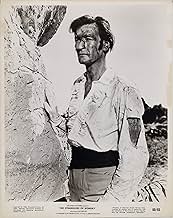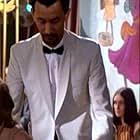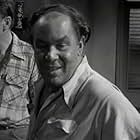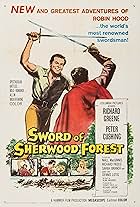IMDb RATING
6.2/10
1.4K
YOUR RATING
In the 1830s, a captain in the East India Company lobbies to investigate the criminal Thugee Cult of Kali, an organized crime group of stranglers and thieves.In the 1830s, a captain in the East India Company lobbies to investigate the criminal Thugee Cult of Kali, an organized crime group of stranglers and thieves.In the 1830s, a captain in the East India Company lobbies to investigate the criminal Thugee Cult of Kali, an organized crime group of stranglers and thieves.
Roger Delgado
- Bundar
- (uncredited)
Marie Devereux
- Karim
- (uncredited)
Margaret Gordon
- Dorothy Flood
- (uncredited)
John Harvey
- Burns
- (uncredited)
Jack McNaughton
- Corp. Roberts
- (uncredited)
Warren Mitchell
- Merchant
- (uncredited)
Michael Nightingale
- Sidney Flood
- (uncredited)
Walter Randall
- Thuggee Cult Member
- (uncredited)
Steven Scott
- Walters
- (uncredited)
Ewen Solon
- Camel Vendor
- (uncredited)
- Director
- Writer
- All cast & crew
- Production, box office & more at IMDbPro
Featured reviews
THE STRANGLERS OF BOMBAY is included on a DVD of another Hammer film, THE TERROR OF THE TONGS. Both films are very similar, though STRANGLERS is definitely the better of the two despite the absence of big name actors. This is because the film did a great job of making the sets look like India and using actors that might be Indian--whereas in TERROR, English actors almost exclusively played Chinese parts (making the film look really cheesy).
Amazingly, THE STRANGLERS OF BOMBAY is based on a true story, though I am pretty sure the names and a few details were fictionalized. In the nineteenth century, a bizarre cult dedicated to Kali (the goddess of death and destruction) was ultimately destroyed by the British in India. This cult not only adored Kali, but was dedicated to murder and robbery--and it was apparently a pretty serious threat.
The film gets very high marks for its script and direction. The film is exciting, well-paced and engaging. Despite having little of the cache of many other Hammer films (no Christopher Lee or Peter Cushing) and being in black and white, it's as solid and exciting a drama as you can find from this studio.
Amazingly, THE STRANGLERS OF BOMBAY is based on a true story, though I am pretty sure the names and a few details were fictionalized. In the nineteenth century, a bizarre cult dedicated to Kali (the goddess of death and destruction) was ultimately destroyed by the British in India. This cult not only adored Kali, but was dedicated to murder and robbery--and it was apparently a pretty serious threat.
The film gets very high marks for its script and direction. The film is exciting, well-paced and engaging. Despite having little of the cache of many other Hammer films (no Christopher Lee or Peter Cushing) and being in black and white, it's as solid and exciting a drama as you can find from this studio.
There's no getting around the Imperialist/Colonialist undertones in this one, only made worse by the various video guides which claim it is based on "actual events." It isn't quite as bad as Fu Manchu to the Chinese, but I suspect many Indians would find this pretty inaccurate and offensive. Still, looked at as a horror movie, it is pretty fun, and it seems to include more explicit depictions of violence even than other Hammer films of the time – perhaps the claim of historical authenticity made it easier to get away with gore in England at this time. I particularly enjoyed George Pastell's performance, similar in many ways to the one he gave in the previous year's adaptation of "the Mummy." The various tensions among the British colonial officers also add a nice touch, and the direction and cinematography are top-notch, as awkward as the material sometimes gets.
The Stranglers of Bombay is out of Hammer Film Productions. It's directed by Terence Fisher and written by David Zelag Goodman. It stars Guy Rolfe, Jan Holden, Andrew Cruickshank, George Pastell, Marne Maitland and Paul Stassino. Music is by James Bernard and cinematography by Arthur Grant.
For hundreds of years there existed in India a perverted religious sect, dedicated to the wanton destruction of human life....
So secret was this savage cult that even the British East Indian Company, rulers of the country at the time, was unaware of their existence....
So it begins, a compact and often violent retelling of the Thuggee Cult in India in the 1820s. It was considered strong stuff back on release and had the head suits at the BBFC shifting uneasily in their office chairs. It's a film that has also fallen unfairly into the realm where political correctness dwells, where some folk are seemingly obsessed with decrying old movies for their outdated political portrayals. This deserves better, for it's a very good script, where although the history is difficult to pin down as being correct, it does at least show a care and attention to detail where the Thugee Cult is concerned.
It's also a good old adventure yarn, full of intrigue, peril and detective work. Fisher directs at a clip, never allowing the plot to stagnate, and the low budget afforded the project is barely evident amongst some very effective sets. Cast are mostly good value for money, with lead players Rolfe perfectly restrained as an officer desperately trying to be heard and Pastell owning the film as the High Priest of Kali; in fact he is revelling in the bad guy role. Bernard provides an ear banging effective musical accompaniment.
Torture, maiming, heroics and a clever mongoose, something for everyone here! 7/10
For hundreds of years there existed in India a perverted religious sect, dedicated to the wanton destruction of human life....
So secret was this savage cult that even the British East Indian Company, rulers of the country at the time, was unaware of their existence....
So it begins, a compact and often violent retelling of the Thuggee Cult in India in the 1820s. It was considered strong stuff back on release and had the head suits at the BBFC shifting uneasily in their office chairs. It's a film that has also fallen unfairly into the realm where political correctness dwells, where some folk are seemingly obsessed with decrying old movies for their outdated political portrayals. This deserves better, for it's a very good script, where although the history is difficult to pin down as being correct, it does at least show a care and attention to detail where the Thugee Cult is concerned.
It's also a good old adventure yarn, full of intrigue, peril and detective work. Fisher directs at a clip, never allowing the plot to stagnate, and the low budget afforded the project is barely evident amongst some very effective sets. Cast are mostly good value for money, with lead players Rolfe perfectly restrained as an officer desperately trying to be heard and Pastell owning the film as the High Priest of Kali; in fact he is revelling in the bad guy role. Bernard provides an ear banging effective musical accompaniment.
Torture, maiming, heroics and a clever mongoose, something for everyone here! 7/10
1959's THE STRANGLERS OF BOMBAY is easily director Terence Fisher's least known Hammer horror, and one rarely screened until its revival in the 2000s. Shot in gritty black and white rather than the usual color, it foreshadows a similar effort the following year, "The Terror of the Tongs," a star vehicle for Christopher Lee as Hong Kong tong leader Chung King, while this film boasts the underrated George Pastell as the High Priest of the secret cult of Kali, leaving behind millions of victims all garroted by the sacred cloth. Top billed Guy Rolfe ("Mr. Sardonicus") plays Captain Harry Lewis of the British East India Company, who has spent months in 1829 Bombay trying to find answers as to the mysterious disappearances of traveling caravans of various goods robbing the English of their profits (the corpses swiftly and ruthlessly buried in shallow graves). His superior, Colonel Henderson (Andrew Cruickshank), appoints an old school chum as chief investigator rather than Lewis, Captain Christopher Connaught-Smith (Allan Cuthbertson), a supremely pompous twit who simply conducts interrogations while seated behind his desk. Lewis decides to resign after his manservant, Ram Das (Tutte Lemkow), suffers a terrible fate (his hand cut off and sent to Lewis) while searching for his brother Gopali Das (David Spenser), revealed not only to be the newest recruit to the cult but also tasked to strangle his own beloved sibling. The level of brutality is unprecedented even for Hammer, and all the better for being so effectively rendered, though possibly cut for television. Two careless followers are punished for betrayal to Kali by having their eyes gouged out (we see the eye sockets following the gruesome deed), corpses have their stomachs slit prior to burial, all sadly historically accurate. It looks like curtains for a captive Lewis, staked out under the mercilessly hot sun waiting for a cobra to strike...surprise! He just happens to have brought along his pet mongoose, ably dispatching the venomous reptile, an ill omen that forces the high priest to set Lewis free. It's amazing how tiny Bray Studios could manage to convey far off places when never venturing far from the Thames, their professionalism led by production designer Bernard Robinson, who often lent his own props for a scene (for instance, the huge globe in the Castle Dracula library in "Horror of Dracula").
If the British did accomplish one good thing in India it was getting rid of the strangling cult Thugee. It took years to eradicate them and there are some who would say they've not been completely eradicated. But if India had been another planet and the British were operating under the Prime Directive it would have made for some interesting history.
As it was this particular film, The Stranglers Of Bombay takes place in the early part of the 18th century when India was ruled not by the crown directly, but through the British East India Company. The soldiers you see report to them in London and the idea of course is take care of whatever is slowing down company profits.
Guy Rolfe who has played some really nasty villains in such films as Ivanhoe, Taras Bulba, and King Of The Khyber Rifles is a time serving captain in their army who has spent twenty years in India and is rather steeped in their culture. He's the right man for finding out what's at the bottom of a lot of mysterious disappearances, but Colonel Andrew Cruickshank selects the arrogant and fatuous Allan Cuthbertson, newly arrived in India for the job. Kind of dumb, but if he had given Rolfe a free hand we wouldn't have had much of a film.
Classic movie fans recall Eduardo Ciannelli as the Guru of the Thugs in Gunga Din who had some really ambitious goals for followers. The head of the cult here is far more local and a man not quite of Ciannelli's vision of eradicating the British and sweeping the world for Kali.
There were some plot holes in the script or otherwise I would have given The Stranglers Of Bombay a higher rating. Still it was an unusual subject for Hammer films, no unworldly demons or monsters to deal with, just some very human villainy.
As it was this particular film, The Stranglers Of Bombay takes place in the early part of the 18th century when India was ruled not by the crown directly, but through the British East India Company. The soldiers you see report to them in London and the idea of course is take care of whatever is slowing down company profits.
Guy Rolfe who has played some really nasty villains in such films as Ivanhoe, Taras Bulba, and King Of The Khyber Rifles is a time serving captain in their army who has spent twenty years in India and is rather steeped in their culture. He's the right man for finding out what's at the bottom of a lot of mysterious disappearances, but Colonel Andrew Cruickshank selects the arrogant and fatuous Allan Cuthbertson, newly arrived in India for the job. Kind of dumb, but if he had given Rolfe a free hand we wouldn't have had much of a film.
Classic movie fans recall Eduardo Ciannelli as the Guru of the Thugs in Gunga Din who had some really ambitious goals for followers. The head of the cult here is far more local and a man not quite of Ciannelli's vision of eradicating the British and sweeping the world for Kali.
There were some plot holes in the script or otherwise I would have given The Stranglers Of Bombay a higher rating. Still it was an unusual subject for Hammer films, no unworldly demons or monsters to deal with, just some very human villainy.
Storyline
Did you know
- TriviaAll scenes shot in the marketplace/village were shot at Bray Studios on the revamped set that was constructed for "Horror of Dracula (1958)." Once "Stranglers" was completed in 1959, the set was completely torn down. The sequences where Guy Rolfe's character goes to meet Allan Cuthbertson's character, the capture of two of the Thuggees in the process and the caravan sequences were shot at the sand-and0gravel quarry in Gerrard's Cross, Buckinghamshire. The tiger hunt and the scene where Rolfe's character finds more grave sites was filmed at the Callow Hill Sandpits in Virginia Water, Egham, in Surrey.
- GoofsThe pistol used in several scenes by Captain Lewis and Captain Connaught-Smith was a revolver. The time frame for this film was set in the 1820's. The revolver wouldn't be invented and patented until 1836.
- Quotes
Patel Shari: Whoever rules decides the truth.
- Alternate versionsFor its UK cinema release the film was cut by the BBFC with edits to the kicking of Lewis by thuggees in an alleyway, and the removal of 'reaction' shots of Karim watching men being branded and strangled. The same print was then cut by a further 7 secs for the 1996 video release with additional edits to remove a scene of a mongoose fighting a snake.
- ConnectionsFeatured in Aweful Movies with Deadly Earnest: The Stranglers of Bombay (1966)
- How long is The Stranglers of Bombay?Powered by Alexa
Details
- Runtime1 hour 20 minutes
- Color
- Aspect ratio
- 2.35 : 1
Contribute to this page
Suggest an edit or add missing content

Top Gap
By what name was The Stranglers of Bombay (1959) officially released in India in English?
Answer































